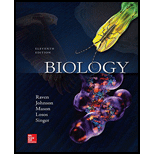
Concept explainers
A genetic map provides
a. the sequence of the DNA in a genome.
b. the relative position of genes on chromosomes.
c. the location of sites of restriction enzyme cleavage in a known sequence of DNA.
d. the banding pattern of a chromosome.
Introduction:
A map that is produced at the level of DNA sequence requires the entire sequence of genome. This thing was impossible once technologically. But, fundamentally there are only two types of maps, physical maps and genetic maps.
Answer to Problem 1U
Correct answer:
A genetic map provides the relative position of genes on chromosomes. Therefore, option b. is correct.
Explanation of Solution
Reason for the correct statement:
Genetic maps are also known as linkage maps. This method is used to identify the distance between the genes and the locus of a gene. This map is very important, because it helps in locating the traits on a chromosome.
Option b. is given as “the relative position of genes on chromosome”.
As, “genetic map provides the relative position of genes on chromosomes”, it is the right answer.
Hence, option b. is correct.
Reasons for the incorrect statements:
Option a. is given as “the sequence of the DNA in a genome”.
The sequence of the DNA in a genome can be provided by genome sequencing. So, it is a wrong answer.
Option c. is given as “the location of sites of restriction enzyme cleavage in a known sequence of DNA”.
Restriction maps provide the location of site of cleavage by restriction enzyme. So, it is a wrong answer.
Option d. is given as “the banding pattern of a chromosome”.
Chromosome maps are studied by cytologists to provide the banding patterns of chromosome. So, it is a wrong answer.
Hence, options a., c. and d. are incorrect.
Genetic maps also called as “linkage maps” are constructed on the basis of frequency obtained from recombination. It provides relative position of a gene on chromosome.
Want to see more full solutions like this?
Chapter 18 Solutions
Biology
- What symbolic and cultural behaviors are evident in the archaeological record and associated with Neandertals and anatomically modern humans in Europe beginning around 35,000 yBP (during the Upper Paleolithic)?arrow_forwardDescribe three cranial and postcranial features of Neanderthals skeletons that are likely adaptation to the cold climates of Upper Pleistocene Europe and explain how they are adaptations to a cold climate.arrow_forwardBiology Questionarrow_forward
- ✓ Details Draw a protein that is embedded in a membrane (a transmembrane protein), label the lipid bilayer and the protein. Identify the areas of the lipid bilayer that are hydrophobic and hydrophilic. Draw a membrane with two transporters: a proton pump transporter that uses ATP to generate a proton gradient, and a second transporter that moves glucose by secondary active transport (cartoon-like is ok). It will be important to show protons moving in the correct direction, and that the transporter that is powered by secondary active transport is logically related to the proton pump.arrow_forwarddrawing chemical structure of ATP. please draw in and label whats asked. Thank you.arrow_forwardOutline the negative feedback loop that allows us to maintain a healthy water concentration in our blood. You may use diagram if you wisharrow_forward
- Give examples of fat soluble and non-fat soluble hormonesarrow_forwardJust click view full document and register so you can see the whole document. how do i access this. following from the previous question; https://www.bartleby.com/questions-and-answers/hi-hi-with-this-unit-assessment-psy4406-tp4-report-assessment-material-case-stydu-ms-alecia-moore.-o/5e09906a-5101-4297-a8f7-49449b0bb5a7. on Google this image comes up and i have signed/ payed for the service and unable to access the full document. are you able to copy and past to this response. please see the screenshot from google page. unfortunality its not allowing me attch the image can you please show me the mathmetic calculation/ workout for the reult sectionarrow_forwardIn tabular form, differentiate between reversible and irreversible cell injury.arrow_forward
 Human Heredity: Principles and Issues (MindTap Co...BiologyISBN:9781305251052Author:Michael CummingsPublisher:Cengage Learning
Human Heredity: Principles and Issues (MindTap Co...BiologyISBN:9781305251052Author:Michael CummingsPublisher:Cengage Learning Concepts of BiologyBiologyISBN:9781938168116Author:Samantha Fowler, Rebecca Roush, James WisePublisher:OpenStax CollegeEssentials of Pharmacology for Health ProfessionsNursingISBN:9781305441620Author:WOODROWPublisher:Cengage
Concepts of BiologyBiologyISBN:9781938168116Author:Samantha Fowler, Rebecca Roush, James WisePublisher:OpenStax CollegeEssentials of Pharmacology for Health ProfessionsNursingISBN:9781305441620Author:WOODROWPublisher:Cengage
 Biology: The Dynamic Science (MindTap Course List)BiologyISBN:9781305389892Author:Peter J. Russell, Paul E. Hertz, Beverly McMillanPublisher:Cengage Learning
Biology: The Dynamic Science (MindTap Course List)BiologyISBN:9781305389892Author:Peter J. Russell, Paul E. Hertz, Beverly McMillanPublisher:Cengage Learning Biology Today and Tomorrow without Physiology (Mi...BiologyISBN:9781305117396Author:Cecie Starr, Christine Evers, Lisa StarrPublisher:Cengage Learning
Biology Today and Tomorrow without Physiology (Mi...BiologyISBN:9781305117396Author:Cecie Starr, Christine Evers, Lisa StarrPublisher:Cengage Learning





